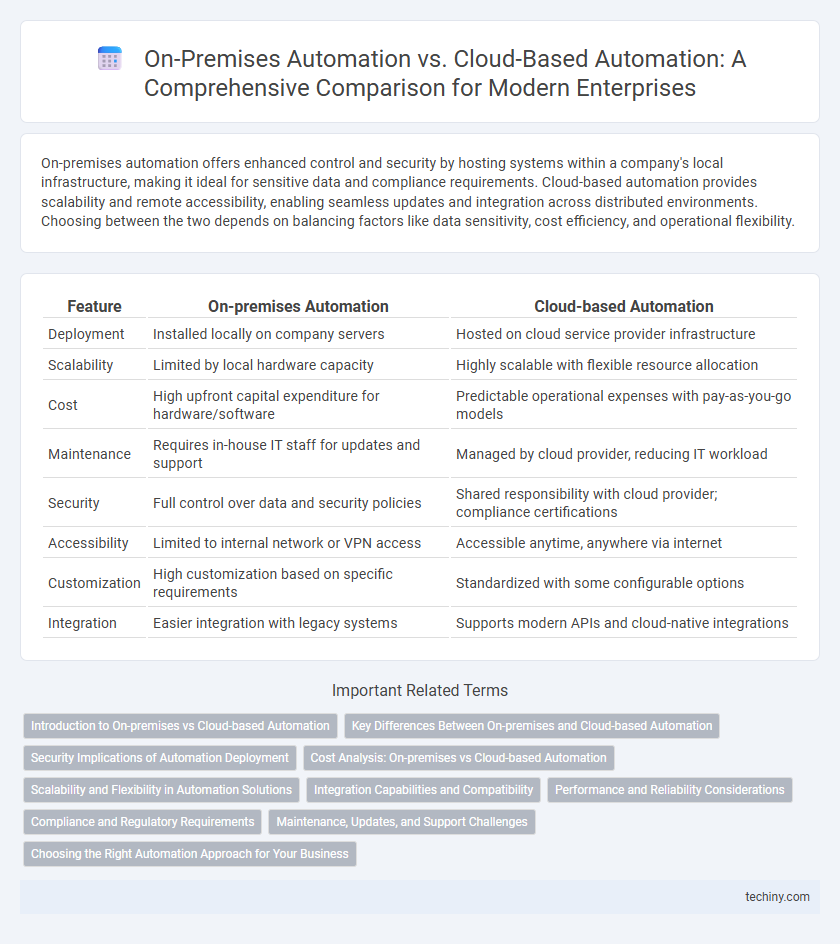On-premises automation offers enhanced control and security by hosting systems within a company's local infrastructure, making it ideal for sensitive data and compliance requirements. Cloud-based automation provides scalability and remote accessibility, enabling seamless updates and integration across distributed environments. Choosing between the two depends on balancing factors like data sensitivity, cost efficiency, and operational flexibility.
Table of Comparison
| Feature | On-premises Automation | Cloud-based Automation |
|---|---|---|
| Deployment | Installed locally on company servers | Hosted on cloud service provider infrastructure |
| Scalability | Limited by local hardware capacity | Highly scalable with flexible resource allocation |
| Cost | High upfront capital expenditure for hardware/software | Predictable operational expenses with pay-as-you-go models |
| Maintenance | Requires in-house IT staff for updates and support | Managed by cloud provider, reducing IT workload |
| Security | Full control over data and security policies | Shared responsibility with cloud provider; compliance certifications |
| Accessibility | Limited to internal network or VPN access | Accessible anytime, anywhere via internet |
| Customization | High customization based on specific requirements | Standardized with some configurable options |
| Integration | Easier integration with legacy systems | Supports modern APIs and cloud-native integrations |
Introduction to On-premises vs Cloud-based Automation
On-premises automation involves deploying automation tools and software within an organization's local infrastructure, ensuring complete control over data and processes. Cloud-based automation leverages remote servers and internet connectivity to enable scalable, flexible automation solutions accessible from anywhere. Both approaches offer distinct advantages in security, cost, and maintenance depending on organizational needs and regulatory requirements.
Key Differences Between On-premises and Cloud-based Automation
On-premises automation requires organizations to manage and maintain their own infrastructure, offering greater control and security but higher upfront costs and limited scalability. Cloud-based automation leverages remote servers, providing flexible, scalable solutions with lower initial investment and automatic updates. Key differences include deployment speed, cost structure, maintenance responsibility, and accessibility, with cloud-based options excelling in agility and on-premises favoring customization and data sovereignty.
Security Implications of Automation Deployment
On-premises automation offers enhanced security control by keeping sensitive data within a company's local infrastructure, minimizing exposure to external threats and regulatory compliance risks. Cloud-based automation introduces potential vulnerabilities through multi-tenant environments and internet-based access but benefits from advanced encryption, continuous monitoring, and scalable security services provided by major cloud vendors. Organizations must evaluate the trade-offs between localized security management and the robust, automated security features inherent in cloud platforms to align with their compliance requirements and risk tolerance.
Cost Analysis: On-premises vs Cloud-based Automation
On-premises automation requires substantial upfront capital expenditure for hardware, software licenses, and ongoing maintenance costs, leading to higher total cost of ownership. Cloud-based automation offers a pay-as-you-go pricing model, reducing initial investment and enabling scalable resource allocation that aligns with business needs. Organizations must evaluate long-term operational expenses, including IT staffing and infrastructure upgrades for on-premises solutions, against variable cloud subscription fees and potential data transfer costs.
Scalability and Flexibility in Automation Solutions
On-premises automation provides direct control over infrastructure but often faces scalability limitations due to physical resource constraints and higher upfront costs. Cloud-based automation offers dynamic scalability and enhanced flexibility, enabling businesses to quickly adjust resources and deploy workflows across distributed environments. This elasticity supports faster innovation cycles and efficient handling of varying workloads without significant capital investment.
Integration Capabilities and Compatibility
On-premises automation offers robust integration capabilities with legacy systems and specialized hardware, ensuring seamless compatibility within existing IT infrastructure. Cloud-based automation excels in scalability and supports a wide array of APIs and third-party services, enabling dynamic integration across diverse platforms. Organizations selecting between these options must evaluate their current system architecture, data sensitivity, and future scalability requirements to determine the optimal automation approach.
Performance and Reliability Considerations
On-premises automation provides enhanced control over performance due to dedicated hardware resources, reducing latency and ensuring consistent uptime within a localized network environment. Cloud-based automation offers scalability and resilience through distributed infrastructure, but it may face variable latency and dependence on internet connectivity, impacting real-time reliability. Choosing between the two involves evaluating workload criticality, network stability, and required performance consistency for optimal automation outcomes.
Compliance and Regulatory Requirements
On-premises automation offers greater control over data security and compliance, making it suitable for organizations with strict regulatory requirements such as HIPAA or GDPR. Cloud-based automation provides scalability and flexibility but may require additional measures to ensure adherence to industry standards and audit trails. Choosing between the two depends on the organization's risk tolerance, data sensitivity, and need for real-time compliance monitoring.
Maintenance, Updates, and Support Challenges
On-premises automation requires substantial in-house maintenance resources and regular manual updates to ensure system reliability and security, leading to higher operational costs. Cloud-based automation offers automated updates and centralized support, reducing downtime and minimizing the technical burden on internal teams. However, cloud solutions depend on internet connectivity and may present challenges in customizing maintenance and support based on specific organizational needs.
Choosing the Right Automation Approach for Your Business
On-premises automation offers enhanced control, security, and customization, making it ideal for businesses with strict compliance requirements and existing IT infrastructure. Cloud-based automation provides scalability, cost-efficiency, and rapid deployment, suitable for organizations seeking flexibility and reduced maintenance overhead. Evaluating factors such as data sensitivity, budget constraints, and long-term scalability goals helps determine the optimal automation approach aligned with your business strategy.
On-premises Automation vs Cloud-based Automation Infographic

 techiny.com
techiny.com